 |
CONSUMER PREFERENCES:Budget Constraints, Consumer Choice |
| << Consumer Behavior:Consumer Preferences, Indifference curves |
| Note it is repeated:Consumer Preferences, Revealed Preferences >> |
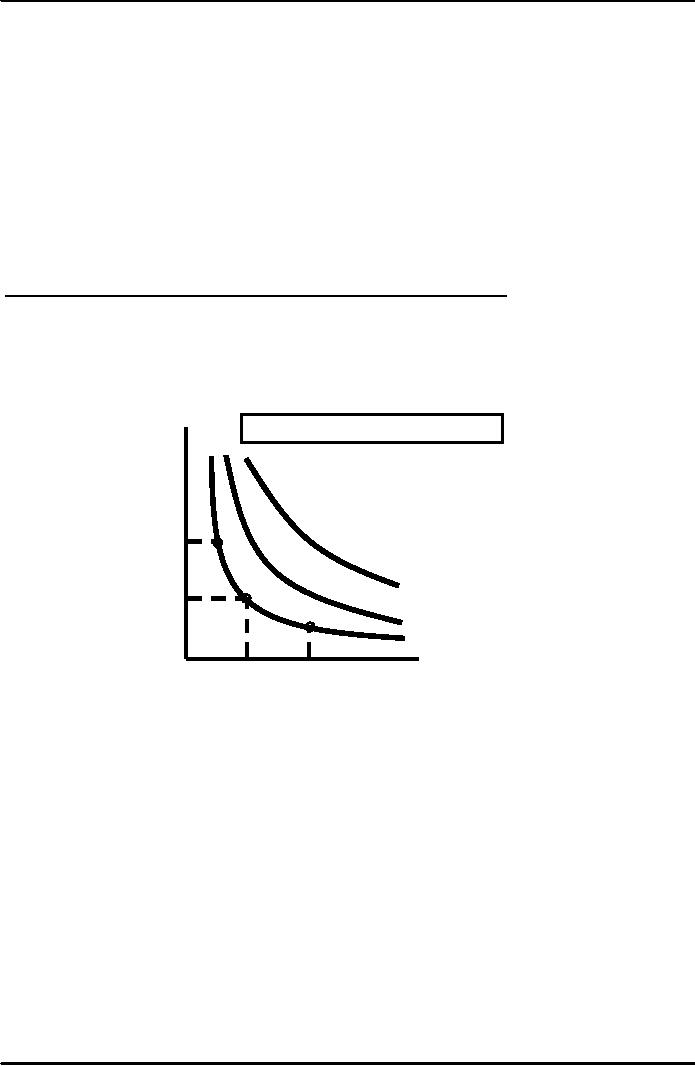
Microeconomics
ECO402
VU
LESSON
7
CONSUMER
PREFERENCES
Utility
Numerical
score representing the
satisfaction that a consumer
gets from a
given
market basket.
If
buying 3 copies of Microeconomics
makes you happier than
buying one shirt,
then
we say that the books
give you more utility
than the shirt.
Utility
Functions
Assume:
The utility function for
food (F) and clothing
(C)
U(F,C)
= F + 2C
Market
Baskets:
F
units
C
units
U
(F, C) = F + 2C
A
8
3
8
+ 2(3) = 14
B
6
4
6
+ 2(4) = 14
C
4
4
4
+ 2(4) = 12
The
consumer is indifferent to A &
B
The
consumer prefers A & B to C
Utility
Functions & Indifference
Curves
Clothing
(units
per
week)
Assume:
U = FC
Market
Basket
U
= FC
15
C
25
= 2.5(10)
A
25
= 5(5)
B
25
= 10(2.5)
C
10
U3 =
100
(Preferred to
A
5
B
U2 =
50
(Preferred to
U1 =
25
Food
0
5
10
15
(units
per week)
Ordinal
Versus Cardinal
Utility
Ordinal
Utility Function:
places
market baskets in the order
of most preferred
to
least preferred, but it does
not indicate how much
one market basket is
preferred
to another.
Cardinal
Utility Function:
utility
function describing the
extent to which one
market
basket is preferred to
another.
Ordinal
Versus Cardinal
Rankings
The
actual unit of measurement
for utility is not
important.
Therefore,
an ordinal ranking is sufficient to
explain how most
individual
decisions
are made.
Budget
Constraints
Preferences
do not explain all of
consumer behavior.
Budget
constraints also limit an
individual's ability to consume in
light of the prices
they
must
pay for various goods
and services.
The
Budget Line
The
budget line indicates all
combinations of two commodities
for which total
money
spent equals total
income.
27
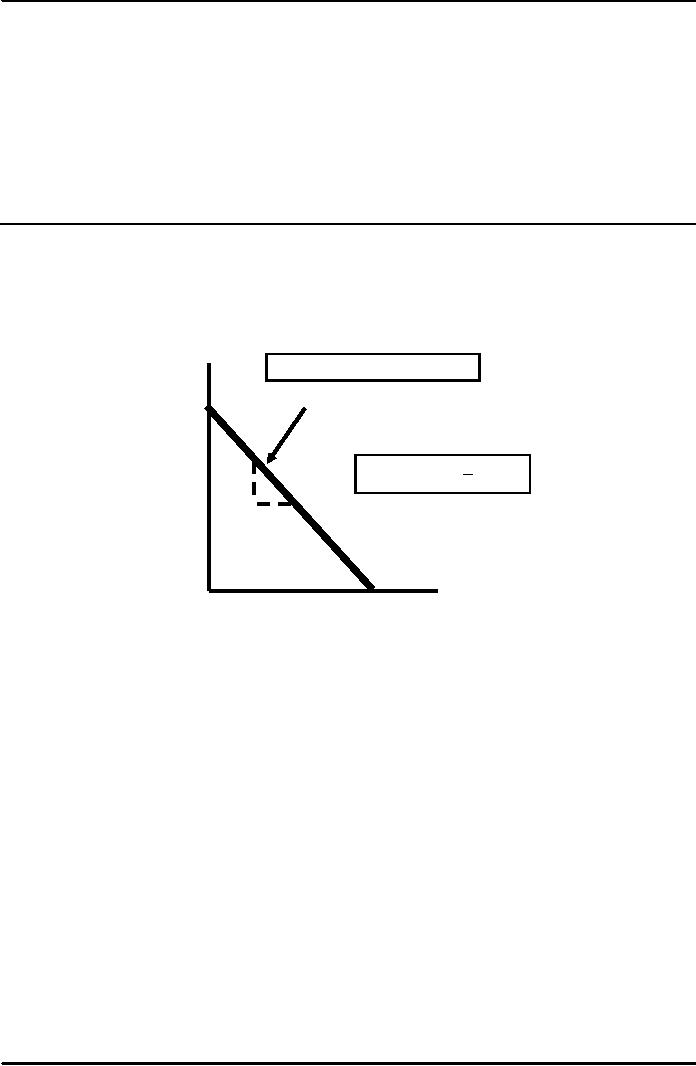
Microeconomics
ECO402
VU
The
Budget Line
Let
F equal the amount of food
purchased, and C is the
amount of clothing.
Price
of food = Pf and price
of
clothing
= Pc
Then
Pf F is the amount of money
spent on food, and Pc C is
the amount of
money
spent on clothing.
The
budget line then can be
written:
PFF +
PCC =
I
Market
Basket
Food
(F)
Clothing
(C)
Total
Spending
Pf
= ($1)
Pc
= ($2)
PfF
+ PcC = I
A
0
40
$80
B
20
30
$80
D
40
20
$80
E
60
10
$80
G
80
0
$80
Clothing
Pc
= $2
Pf =
$1
I
= $80
(units
per
week)
Budget
Line F + 2C = $80
A
(I/PC) = 40
B
30
1
Slope
=
ΔC/ΔF
= -
=
-
PF/PC
1
2
D
20
2
E
10
G
Food
80
= (I/PF) (units per
week)
0
20
40
60
The
Budget Line
As
consumption moves along a
budget line from the
intercept, the
consumer
spends
less on one item and
more on the other.
The
slope of the line measures
the relative cost of food
and clothing.
The
slope is the negative of the
ratio of the prices of the
two goods.
The
slope indicates the rate at
which the two goods
can be substituted
without
changing
the amount of money
spent.
The
vertical intercept (I/PC),
illustrates the maximum
amount of C that can
be
purchased
with income I.
The
horizontal intercept (I/PF),
illustrates the maximum
amount of F that can
be
purchased
with income I.
The
Effects of Changes in Income
and Prices
Income
Changes
An
increase in income causes
the budget line to shift
outward, parallel
to
the original line (holding
prices constant).
A
decrease in income causes
the budget line to shift
inward, parallel to
the
original line (holding
prices constant).
28
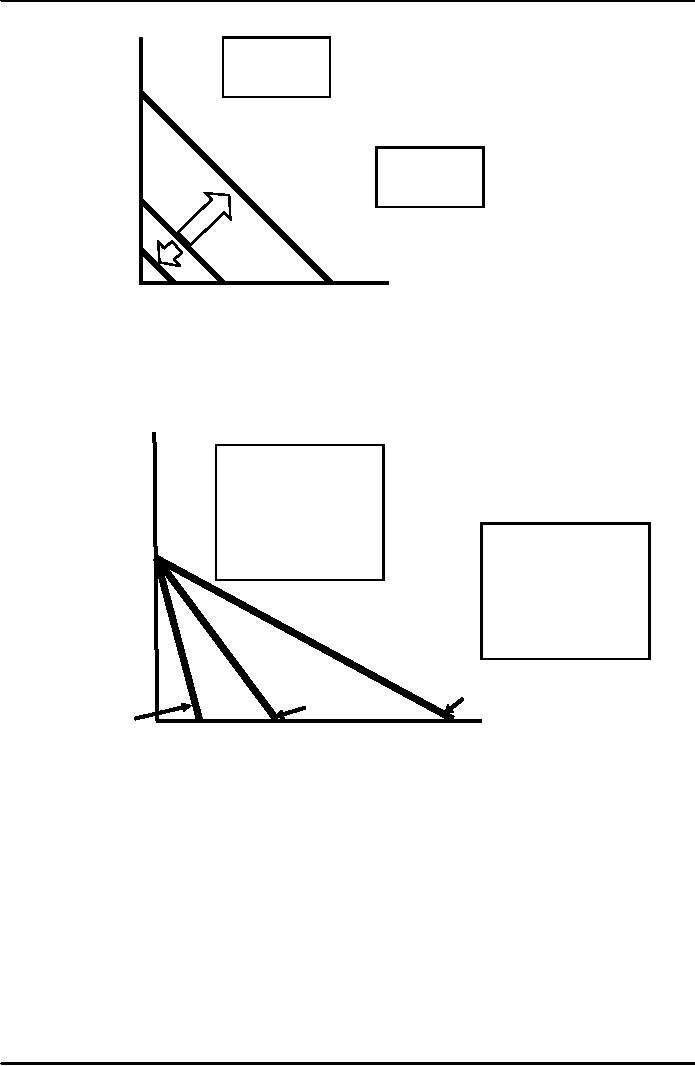
Microeconomics
ECO402
VU
Clothing
A
increase in
(units
income
shifts
per
week)
the
budget line
80
outward
60
A
decrease in
income
shifts
the
budget line
40
inward
L3
20
L2
L1
(I =
(I =
(I =
$40
Food
40
80
120
160
0
(units
per week)
Price
Changes
�
If
the price of one good
increases, the budget line
shifts inward,
pivoting
from
the other good's
intercept.
�
If
the price of one good
decreases, the budget line
shifts outward,
pivoting
from the other good's
intercept.
Clothing
An
increase in the
(units
price
of food to
per
week)
$2.00
changes
the
slope of the
budget
line and
A
decrease in the
rotates
it inward.
40
price
of food to
$.50
changes
the
slope of the
budget
line and
rotates
it outward.
L2
L3
L1
(PF = 1)
(PF =
1/2)
(PF = 2)
Food
40
80
120
160
(units
per week)
The
Effects of Changes in Income
and Prices
Price
Changes
�
If
the two goods increase in
price, but the ratio
of
the two prices is
unchanged,
the slope will not
change.
�
However,
the budget line will
shift inward to a point
parallel to the
original
budget line.
�
If
the two goods decrease in
price, but the ratio of
the two prices is
unchanged,
the slope will not
change.
�
However,
the budget line will
shift outward to a point
parallel to the
original
budget line.
Consumer
Choice
Consumers
choose a combination of goods
that will maximize the
satisfaction they can
achieve,
given the limited budget
available to them.
The
maximizing market basket
must satisfy two
conditions:
1)
It must be located on the
budget line.
29
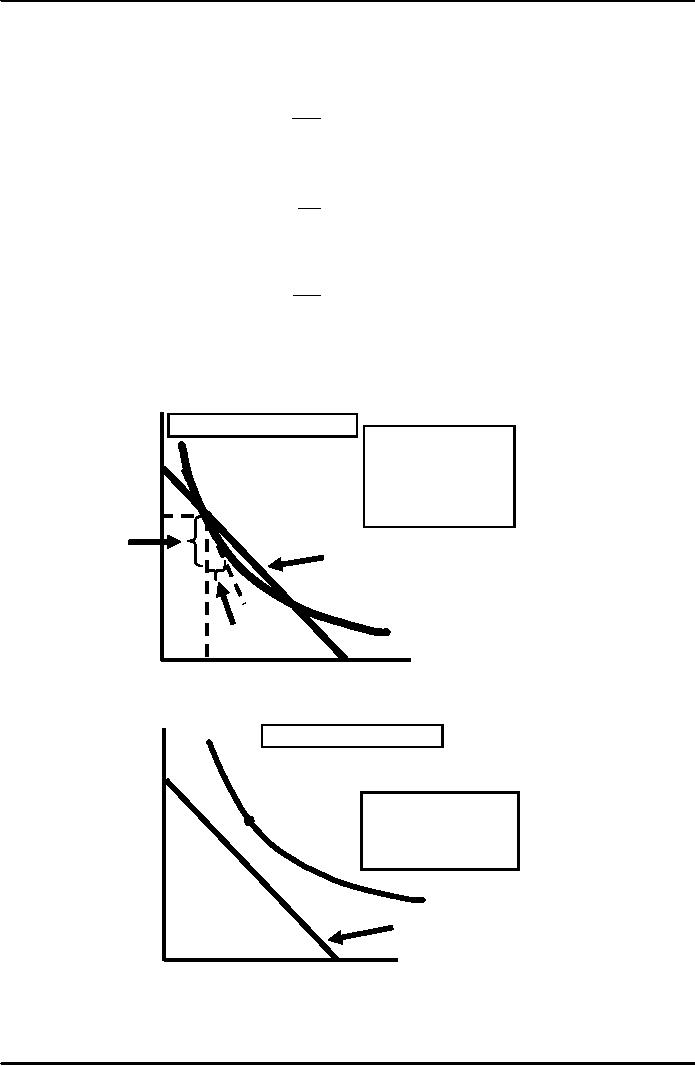
Microeconomics
ECO402
VU
2)
Must give the consumer
the most preferred
combination of goods
and
services.
Recall,
the slope of an indifference
curve is:
ΔC
MRS
=
-
ΔF
Further,
the slope of the budget
line is:
PF
Slope
=
-
PC
Therefore,
it can be said that
satisfaction is maximized
where:
PF
M
RS =
PC
It
can be said that
satisfaction is maximized when
marginal rate of substitution
(of F
and
C) is equal to the ratio of
the prices (of F and
C).
Clothing
Pc
= $2
Pf =
$1
I
= $80
(units
per
Point
B does
not
week)
maximize
satisfaction
40
because
the
MRS
(-(-10/10) = 1
is
greater than the
B
price
ratio (1/2).
30
-10C
Budget
20
U1
+10
0
20
40
80
Food
(units per week)
Clothing
(units
per
Pc
= $2
Pf =
$1
I
= $80
week)
40
Market
basket D
D
cannot
be attained
30
given
the current
budget
constraint.
20
U3
Budget
0
20
40
80
Food
(units per week)
30
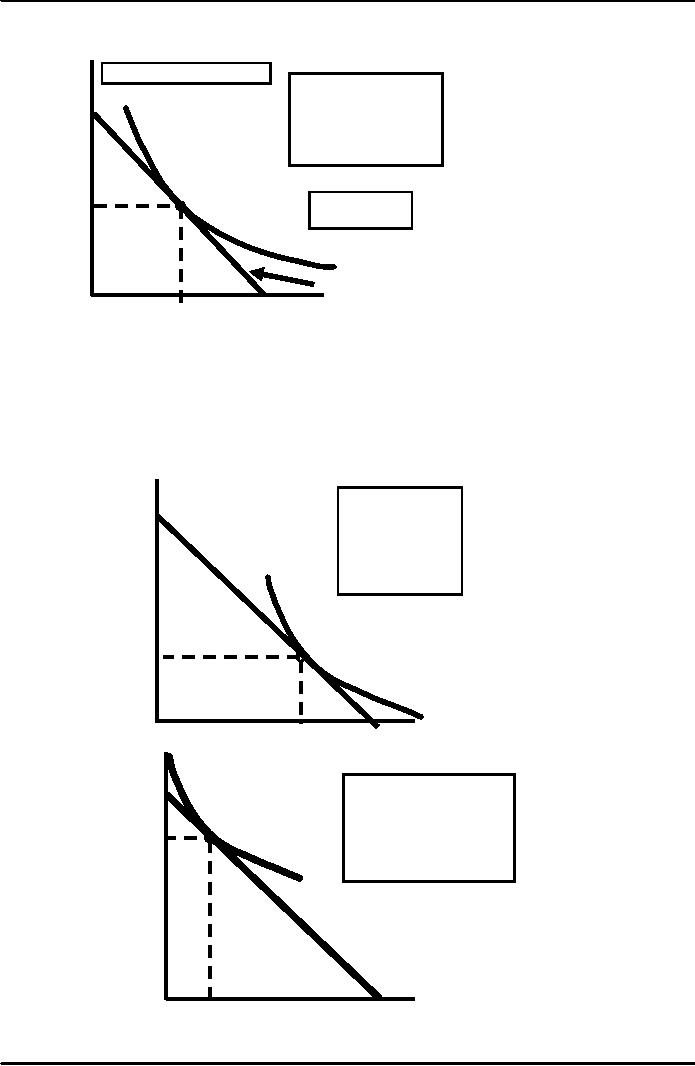
Microeconomics
ECO402
VU
Clothing
(units
per
Pc
= $2
Pf =
$1
I
= $80
week)
At
market basket A
the
budget line and
the
40
indifference
curve are
tangent
and no higher
level
of satisfaction
can
be attained.
30
A
At
A:
20
MRS
=Pf/Pc =
.5
U2
Budget
0
20
40
80
Food
(units per week)
Designing
New Automobiles (II)
Consider
two groups of consumers,
each wishing to spend
$10,000 on the
styling
and performance of
cars.
Each
group has different
preferences.
By
finding the point of
tangency between a group's
indifference curve and
the
budget
constraint auto companies
can design a production and
marketing plan.
Styling
These
consumers
$10,000
are
willing to trade
off
a considerable
amount
of styling
for
some additional
performance
$3,000
$7,000
$10,000
Performance
Styling
These
consumers
$10,000
are
willing to trade
off
a considerable
amount
of
$7,000
performance
for
some
additional
styling
$10,000
Performance
$3,000
31
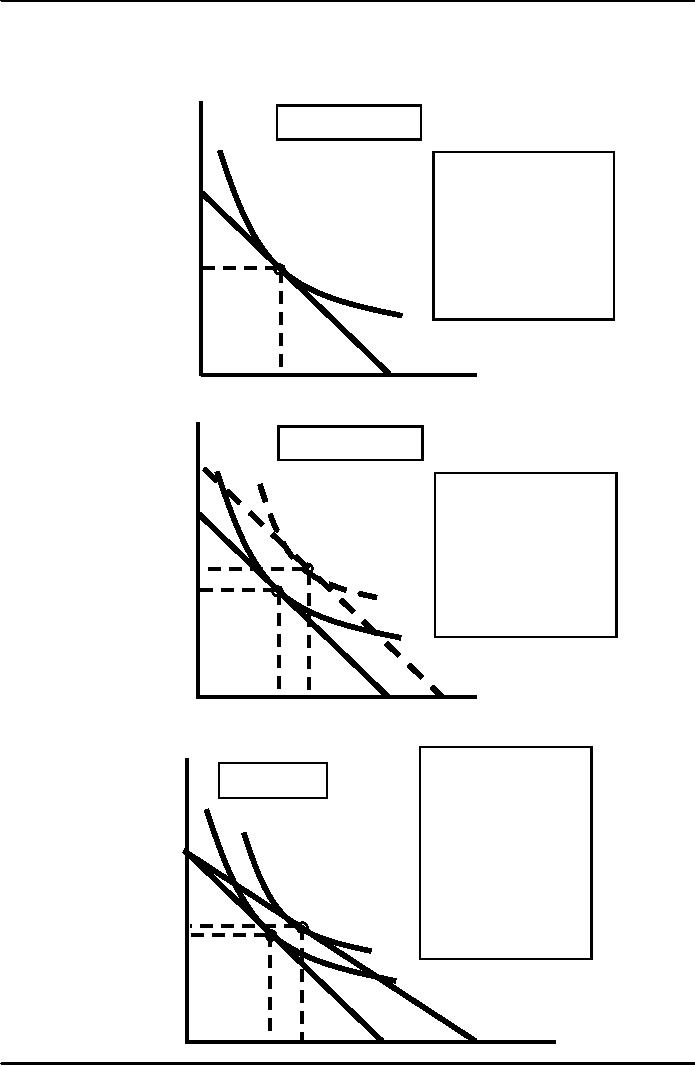
Microeconomics
ECO402
VU
Decision
making & Public
Policy
Choosing
between a non-matching and
matching grant to fund
police
expenditures
Private
Non-matching
Grant
Expenditures
($)
Before
Grant
�
Budget
line: PQ
P
�A:
Preference maximizing
market
basket
�Expenditure
A
R
�OR:
Private
�OS:
Police
U1
Police
O
S
Q
Expenditures
($)
Private
Expenditures
($)
Non-matching
Grant
T
After
Grant
�
Budget line:
TV
P
�B: Preference
maximizing
market
basket
B
U
�Expenditure
A
�OU:
Private
R
U3
�OZ:
Police
U1
Police
O
S
Q
V
Z
Expenditures
($)
Private
Before
Grant
Expenditures
($)
�
Budget line:
PQ
Matching
Grant
�
A: Preference
maximizing
T
market
basket
After
Grant
P
�C: Preference
maximizing
market
basket
Expenditures
�OW: Private
W
R
�OX: Police
C
U2
U1
O
S
Q
R
X
Police
($)
32
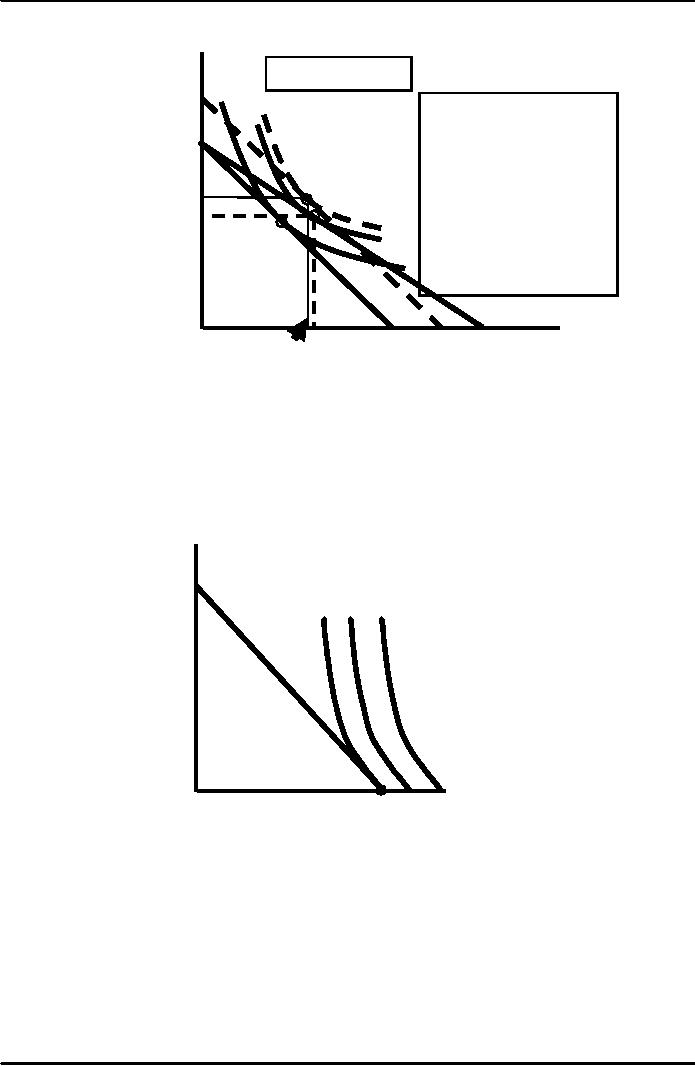
Microeconomics
ECO402
VU
Private
Expenditures
($)
Matching
Grant
T
Non-matching
Grant
�Point B
P
�OU: Private
expenditure
�OZ: Police
expenditure
B
U
Matching
Grant
W
A
�Point C
U3
C
U2
�OW: Private
expenditure
U1 �OX: Police
expenditure
R
O
Q
X
Police
($)
Corner
Solution
A
corner solution exists if a
consumer buys in extremes,
and buys all of
one
category
of good and none of
another.
�
This
exists where the
indifference curves are
tangent to the
horizontal
and
vertical axis.
MRS
is not equal to PA/PB
�
Frozen
Yogurt
(cups
monthly) A
A
corner solution
exists
at point B.
U1
U2
U3
B
Ice
Cream (cup/month)
A
Corner Solution
At
point B, the MRS of ice
cream for frozen yogurt is
greater than the slope of
the
budget
line.
This
suggests that if the
consumer could give up more
frozen yogurt for ice
cream
he
would do so.
However,
there is no more frozen
yogurt to give up!
When a
corner solution arises,
the
consumer's MRS does not
necessarily equal
the
price
ratio.
In
this instance it can be said
that:
MRS
≥
PIceCream /
PFrozen
Yogurt
33
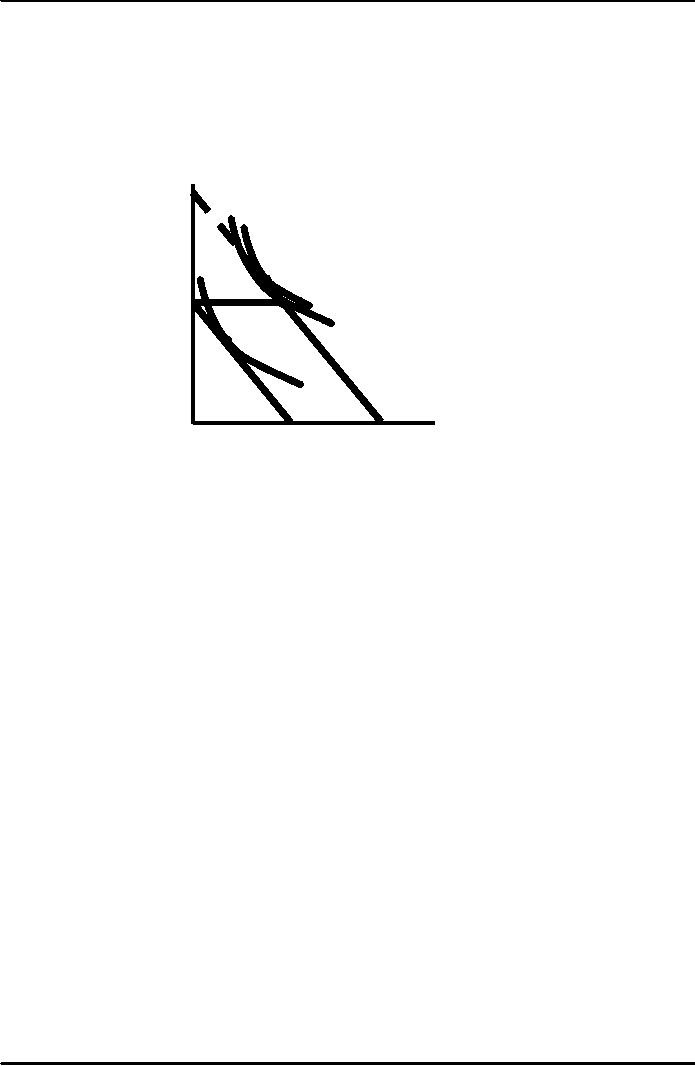
Microeconomics
ECO402
VU
If
the MRS is, in fact,
significantly greater than
the price ratio, then a
small
decrease
in the price of frozen
yogurt will
not alter
the consumer's market
basket.
A
college Trust Fund
Suppose
Jane Doe's parents set up a
trust fund for her
college education.
Originally,
the money must be used
for education.
If
part of the money could be
used for the purchase of
other goods, her
consumption
preferences change.
A
College Trust
Fund
Other
Consumption
($)
A:
Consumption before the trust
fund
The
trust fund shifts the
budget line
B:
Requirement that the trust
fund
C
must
be spent on education
U
P
C:
If the trust could be spent
on
B
other
goods
U
A
U
Q
Education
($)
34
Table of Contents:
- ECONOMICS:Themes of Microeconomics, Theories and Models
- Economics: Another Perspective, Factors of Production
- REAL VERSUS NOMINAL PRICES:SUPPLY AND DEMAND, The Demand Curve
- Changes in Market Equilibrium:Market for College Education
- Elasticities of supply and demand:The Demand for Gasoline
- Consumer Behavior:Consumer Preferences, Indifference curves
- CONSUMER PREFERENCES:Budget Constraints, Consumer Choice
- Note it is repeated:Consumer Preferences, Revealed Preferences
- MARGINAL UTILITY AND CONSUMER CHOICE:COST-OF-LIVING INDEXES
- Review of Consumer Equilibrium:INDIVIDUAL DEMAND, An Inferior Good
- Income & Substitution Effects:Determining the Market Demand Curve
- The Aggregate Demand For Wheat:NETWORK EXTERNALITIES
- Describing Risk:Unequal Probability Outcomes
- PREFERENCES TOWARD RISK:Risk Premium, Indifference Curve
- PREFERENCES TOWARD RISK:Reducing Risk, The Demand for Risky Assets
- The Technology of Production:Production Function for Food
- Production with Two Variable Inputs:Returns to Scale
- Measuring Cost: Which Costs Matter?:Cost in the Short Run
- A Firm’s Short-Run Costs ($):The Effect of Effluent Fees on Firms’ Input Choices
- Cost in the Long Run:Long-Run Cost with Economies & Diseconomies of Scale
- Production with Two Outputs--Economies of Scope:Cubic Cost Function
- Perfectly Competitive Markets:Choosing Output in Short Run
- A Competitive Firm Incurring Losses:Industry Supply in Short Run
- Elasticity of Market Supply:Producer Surplus for a Market
- Elasticity of Market Supply:Long-Run Competitive Equilibrium
- Elasticity of Market Supply:The Industry’s Long-Run Supply Curve
- Elasticity of Market Supply:Welfare loss if price is held below market-clearing level
- Price Supports:Supply Restrictions, Import Quotas and Tariffs
- The Sugar Quota:The Impact of a Tax or Subsidy, Subsidy
- Perfect Competition:Total, Marginal, and Average Revenue
- Perfect Competition:Effect of Excise Tax on Monopolist
- Monopoly:Elasticity of Demand and Price Markup, Sources of Monopoly Power
- The Social Costs of Monopoly Power:Price Regulation, Monopsony
- Monopsony Power:Pricing With Market Power, Capturing Consumer Surplus
- Monopsony Power:THE ECONOMICS OF COUPONS AND REBATES
- Airline Fares:Elasticities of Demand for Air Travel, The Two-Part Tariff
- Bundling:Consumption Decisions When Products are Bundled
- Bundling:Mixed Versus Pure Bundling, Effects of Advertising
- MONOPOLISTIC COMPETITION:Monopolistic Competition in the Market for Colas and Coffee
- OLIGOPOLY:Duopoly Example, Price Competition
- Competition Versus Collusion:The Prisoners’ Dilemma, Implications of the Prisoners
- COMPETITIVE FACTOR MARKETS:Marginal Revenue Product
- Competitive Factor Markets:The Demand for Jet Fuel
- Equilibrium in a Competitive Factor Market:Labor Market Equilibrium
- Factor Markets with Monopoly Power:Monopoly Power of Sellers of Labor